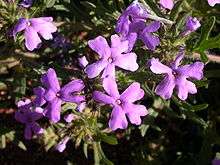Glandularia
| Glandularia | |
|---|---|
 | |
| Glandularia bipinnatifida has chloroplasts acquired from a North American true vervain species via horizontal transfer. | |
| Scientific classification | |
| Kingdom: | Plantae |
| (unranked): | Angiosperms |
| (unranked): | Eudicots |
| (unranked): | Asterids |
| Order: | Lamiales |
| Family: | Verbenaceae |
| Genus: | Glandularia J.F.Gmel. |
| Species | |
|
Many, see text | |

Its chloroplasts derive from a South American Verbena

Glandularia (common name mock vervain or mock verbena) is a genus of annual and perennial herbaceous flowering plants in the family Verbenaceae. They are native to the Americas.
Closely related to the true vervains[1] and sometimes still included with them in Verbena, horizontal chloroplast transfer occurred at least twice and possibly three times between these genera, which are otherwise rather too distinct to warrant unification. The discovery of the signal in the chloroplast genome was announced in 2008 by University of Washington researchers. Somehow, chloroplasts from V. orcuttiana, Swamp Verbena (V. hastata) or a close relative of these had admixed into the G. bipinnatifida germline. Although hybridization runs rampant in the true and mock vervains – the ancestors of the well-known Garden Vervain are quite obscure –, it does not seem to have been the cause of the cross-species gene transfer.[2]
In addition, the researchers discovered the signal of one more transfer event. This had introduced chloroplasts from an ancestral member of the Verbena lineage nowadays found in South America into Glandularia Although all members of the present genus can be distinguished to have a chromosome count of 5, the South American species are diploid, while polyploid hybrid Glandularia are very widespread from northern Central America northwards. The second genetic introgression must have occurred before the genus spread north, as species with the Verbena-like chloroplasts are found all over the Americas. Since the new chloroplast genes replaced the old ones, it may be that the possibly hybridogenic G. bipinnatifida actually underwent horizontal chloroplast transfer twice in its evolutionary history.[2]
Selected species[3]
|
|
Footnotes
References
| Wikimedia Commons has media related to Glandularia. |
| Wikispecies has information related to: Glandularia |
- Botta, S.M.: Martinez, S. & Mulgura de Romero, M.E. (1995): Novedades nomenclaturales en Verbenaceae ["Nomenclatural revisions in Verbenaceae"]. Hickenia 2: 127-128.
- United States Department of Agriculture (USDA) (1999): Germplasm Resources Information Network - Glandularia. Version of 1999-AUG-30. Retrieved 2008-AUG-07.
- United States Department of Agriculture (USDA) [2008]: USDA Plants Profile: Verbena bonariensis. Retrieved 2008-AUG-07.
- Yuan, Yao-Wu & Olmstead, Richard G. (2008): A species-level phylogenetic study of the Verbena complex (Verbenaceae) indicates two independent intergeneric chloroplast transfers. Mol. Phylogenet. Evol. 48(1): 23-33. doi:10.1016/j.ympev.2008.04.004 (HTML abstract)
_W_IMG_1613.jpg)